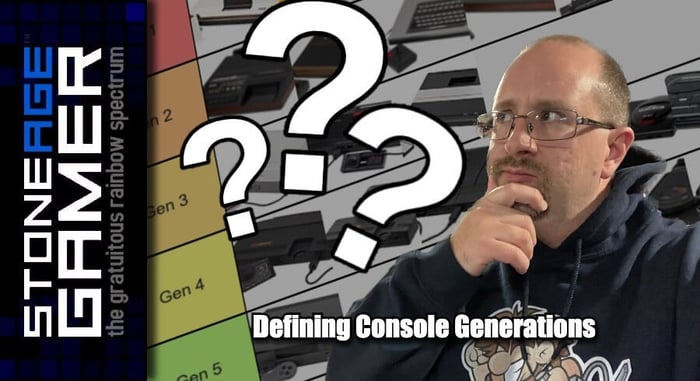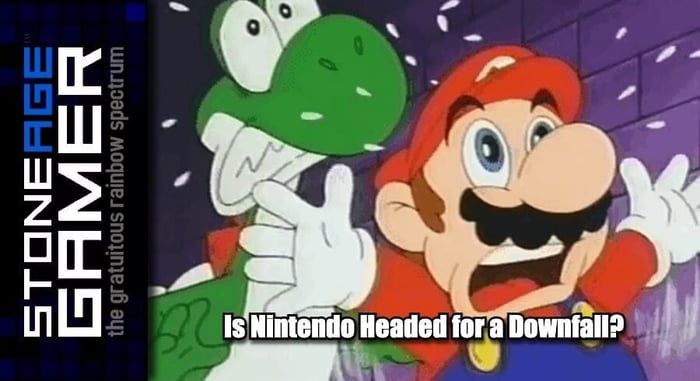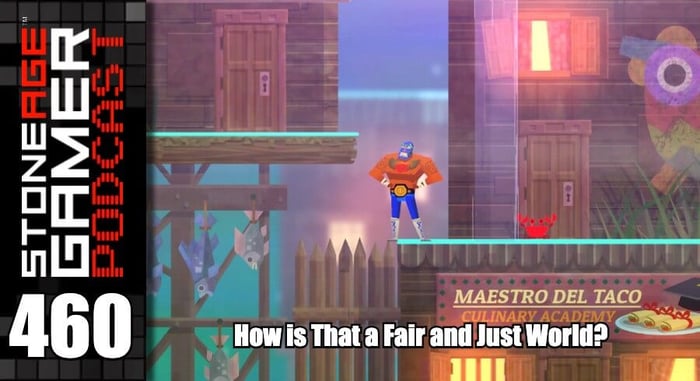
Defining Console Generations
When console wars arguments rear their ugly heads, someone will inevitably claim one system's library was the worst or best of its generation. But what exactly are the lines in these console generations? This time in the Gratuitous Rainbow Spectrum, Kris attempts to answer that question. Bring out the spreadsheet!!!
Transcript of the video:
Console generations are weird because not every system comes out in a clearly defined cycle. But when having volatile conversations online about which system is better than which, it’s important to know where you’re coming from. So let’s get to work on defining what systems belong in what generation.
The first thing we want to do is define a generation. How I’ve always looked at this is partly based on how powerful a system is but more importantly, what its intent was. Was this system designed to compete with said other systems? Does it technologically align with these contemporaries? Whether or not they ceased to be sold before more consoles of the same generation even made it to market is irrelevant. If you’re basing generations solely on when they were in direct sales competition with one another, it becomes impossible to clearly define lines with stuff like the Master System or PlayStation 1, whose lifespans, especially worldwide, lasted very long. I believe in my heart of hearts that this is the only fair way to compare these systems. Also, I’m not going to hit every system ever made in here. I’m just talking about home consoles, not handhelds, and some of the more obscure platforms like Arcadia 2001 or Pippin I'm skipping just because if I tried to include everything ever made, I think my head would explode. I’d also doubtlessly forget something. Finally, this is from a US perspective, so if you know of a Japan or European console that’s not here, that’s why. So with all that in mind, let’s get started.
The first generation of game consoles is basically Pong. You’ve got your Odyssey, your various Pong clones, Coleco Telstar, etc. This isn’t much of a conversation starter because there wasn’t much in terms of real competition back then. No matter which system you had, you were probably playing some variation of Pong. Console exclusive games, or Exclusive features, they existed to a degree, but they were all basically the same, and they were all pretty basic. So Gen 1, pretty easily defined. We’ve got your Odysseys, your pong clones, let’s call it a day.
The Second Generation is where things start to get interesting. This is where things also get quite murky thanks to Atari, but we’ll get there. Consoles are now intrinsically different. They have different controllers, different games, different graphics capabilities, the works. Let’s start at the start with what’s widely considered the first major platform with interchangeable cartridges, the fairchild Channel F. Obviously the Atari 2600 fits nicely in here as well. Same goes for the Odyssey 2, and the Intellivision. That one’s ad campaign took direct aim at the 2600, so even though it was a more powerful console, it was definitely the same generation. I think we can safely fit the Vectrex in there too. Now we start to get a little funky. ColecoVision technologically could be considered more of a halfway point between the Atari 2600 and the NES, which makes it seem like it could fit in either generation. However, if we look at the system’s intent, it feels more at home with the 2600 and Intellivision. Now, if we were looking at this from a Japan perspective, this would be even more confusing thanks to the Famicom’s early releases and the SG-1000 being effectively the same dang hardware. But thankfully we’re not, so I say ColecoVision sits firmly in the second generation.
But then we have the Atari 5200. It’s pretty weird to have a console manufacturer have more than one console in the same generation, but the industry was still figuring itself out, and the Atari 5200 in no way feels like its intent was to compete with the likes of the NES. This is a platform meant to stand up to the advancements of the Intellivision and ColecoVision, so even though it’s the next generation of Arati hardware, it didn’t quite make it out of the second generation of gaming consoles.
Next, let’s figure out what goes in the third generation. There was a pretty clear difference in the types of games being made for these platforms, which is where I feel drawing the generational line makes sense. Prior generations were all about trying to replicate the arcade experience at home. This generation saw a shift to games made specifically to be played for longer periods of time in front of a TV. High scores took a back seat to “beating” games with multiple levels, stories, and the like. Like I said, this is a decidedly North American approach, so we’ll be skipping past the Famicom and SG-1000. Here in the US though, there were only really three contenders, the Nintendo Entertainment System, Sega Master System, and Atari 7800. There were a bunch of other smaller ones out there that you could argue live in this generation, but none of them really moved the needle.
The NES is a pretty well-known quantity, so we don't really have to get too much into that here. It effectively owned this generation, and was home to some of the most important game design advancements of all time. Sega’s Master System was no slouch either. It didn’t perform very well here in the US, but it gained a nice foothold in other parts of the world, and while its library was never able to properly compete with Nintendo’s in the states, it’s a heck of a platform. Atari’s effort though, was pretty wild. It doesn’t look or sound quite as good as Nintendo or Sega’s machines, but it’s definitely enough of a step up from the 2600 and 5200 to justify its appearance here.
The fourth generation is where we have to start making some decisions because of a number of unique factors. This is where we saw the first major publicized console war between Nintendo and Sega, a slew of competitors, and the introduction of industry-changing CD-ROMs. First, we have the TurboGrafx-16. There’s definitely an argument to be made that this belongs more as a contemporary to the 8-bit consoles, but let’s be real here, this is where 16-bit gaming started. It’s even in the name! So I believe it firmly lands here, and yes, This goes for the Turbo CD and Turbo Duo as well. The Super NES obviously lands here, as does the Sega Genesis, and just like with the TurboGrafx, as does Sega CD. 32X is sort of a question mark though because it really was aiming to make the Genesis into a 32-bit machine, which could be argued makes it in line with the next generation, but if we’re looking at the intent of the system, I think the idea was more of a stop gap than an actual next generation thing, especially considering the Saturn was right around the corner. It’s also inextricably linked to the Genesis itself, so I think it has to belong here.
Then we have the NeoGeo. This one’s kind of wacky because it stayed on the market for a really long time, but even with its massive price tag and arcade perfect capabilities, there’s no doubt this system belongs in this generation when you look at its games. This naturally also applies to its counterpart the NeoGeo CD.
Sticking with CDs, let’s discuss the ill-fated Philips CD-i. This is a hard one because it wasn’t really solely a games machine. This was a multimedia player. On one hand, its intent was clearly closer to what the following generation was aiming for. On the other hand, it was released in 1992 and its tech was way closer in power to what we were seeing on Sega CD. It really does feel like a mid-generational machine, but I’m inclined to put it in the fifth generation. Let me explain. Yes, it was released pretty early, but in terms of what this platform aimed to be, it wasn’t out there to take on the likes of the Genesis or SNES. This thing wanted to usher in a new generation with movie and music playback, and more PC-CD-ROM style adventures. I can see the argument for it sticking with the previous gen, but I honestly believe that if you look at what this system was aiming for, it has more in line with the PlayStation than the Super NES. It may seem weird, but I think this is more of a jump start to the 5th generation than a late 4th gen machine.
Speaking of platforms that never lived up to their potential, we have the 3DO. I’ve seen it argued that since this platform died out in 1996 it should be considered part of the fourth generation, but again, this wasn’t a platform designed to take on the Super NES and Genesis. This was a next generation system. That it didn’t live long enough to see the launch of the Nintendo 64 doesn’t change that. 3DO is firmly a 5th generation machine.
So what of the Virtual Boy? Based on its name, we could ignore it entirely and stick it with the handhelds, but in reality that thing was no more portable than a Super Nintendo, even if it could technically run on batteries. So where does it belong? I think it goes here. It only had 14 releases in the US, but while they weren’t all that different from what you’d see on the SNES or Genesis, they were presented like an advancement over what had come before. I think the intent of the Virtual Boy was to be something new more than competition for stuff like the Sega CD or 32X. This was Nintendo’s 32-bit machine for better or worse, and well, I think it goes here.
Then there’s the Jaguar. Here’s a tough one because on one hand you have games like Rayman, Bubsy, and Pitfall: The Mayan adventure that were well in line with fourth generation stuff. But this system also pushed polygons with stuff like Cybermorph, and it did so on a level that 16-bit machines simply couldn’t. While I don’t believe for a second that it achieved this, I do believe this platform’s intent was to compete with the likes of whatever Nintendo and Sega were coming out with next. Like the 3DO, it didn’t live long enough to even take its swing, but I’m going to put it here with CD-i and 3DO. Yes, Jaguar games feel a lot more in line with the 32X than anything else, but I’m sticking to my guns, and yes, Jag CD goes here too.
Then of course, we have the three consoles that properly defined this generation, the Sega Saturn, Sony PlayStation, and Nintendo 64. We all know how that turned out for all parties involved. Welcome to the top of the mountain, PlayStation.
Things start to become considerably more clearly defined from here. Sega kicked off the sixth generation with the Dreamcast. I’ve heard it argued that this one belongs in the 5th generation, but that’s bananas. Dreamcast games have way more in common with what we were seeing in this generation than the last one. Nintendo finally ditched cartridges with the GameCube, Microsoft entered the market with Xbox, and Sony absolutely dominated with its DVD-player powered PS2.
I think the only real point of confusion from here on out lies with Nintendo. Obviously we have the generational leaps of the Xbox 360 and PlayStation 3, boom and boom. but the Wii wasn’t really a more powerful console, just a radically different one. That said, a lot of this generation’s games were defined by the advent of motion controls, so I believe in my heart of hearts that Wii belongs in the same generation as Microsoft and Sony’s behemoths.
The Eighth generation sits in a similar boat thanks to Nintendo. PlayStation 4 and Xbox One are obvious next gen consoles, but then you have to contend with the Wii U.. Though its power is on par with the previous generation, its intent was to be Nintendo’s next generation system, so I say it goes here. However, that system had an unusually short lifespan, which led to the Switch releasing well before everybody else’s next generation, and it did so without achieving anywhere near the power capabilities of even this generations’s playstation and xboxes. That said, based on where we are now, I think Switch lives in the 9th gen.
And that catches up to now, in the ninth generation of gaming platforms. Microsoft Xbox Series X/S, Sony PlayStation 5, and Nintendo Switch are the clear market leaders, but there are a few other doodads that belong here, like Amazon Luna and Google Stadia. These things don’t work with physical media, and they’re more streaming platforms than anything else, but they do seem to be designed to be competitors to Microsoft and Sony’s efforts. Or at least they were before Stadia kicked the bucket, but again, lifespan doesn’t necessarily determine generational status. It’s all about the intent! So what of the Atari VCS? Yes, this thing is still a thing, and it’s still regularly getting new releases. It’s difficult to see what this console’s intent was because well, it’s such an odd duck. It’s not powerful enough to compete with even most last gen consoles, but if I don’t miss my guess, I don’t think it’s intended to be a competitor in that regard. More a competitor for how you spend your time. That being the case, I think we have to base it on when it was released, which was 2020 for backers and 2021 for widespread release. I’m going to plop that one right here in gen 9.
So let’s take a look at the big picture.
I firmly believe that this is where console generational lines belong. Now feel free to argue to your heart's content.





